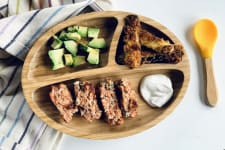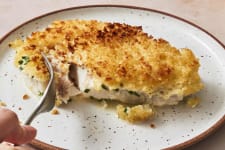
Congee with Hot Smoked Sockeye
September 9th, 2021Hot Smoked Salmon Elevates a Bowl of Rice Porridge for a Rustic Breakfast
Hot smoked sockeye salmon congee is just the thing for savory breakfast lovers and comfort food appreciators. Think of this rice porridge as a blank canvas, one that you can bring to life with salty morsels of wild-caught fish and a few complementary toppings.
What Is Congee?
Many of us may have first come to know rice porridge as a Chinese dish called congee. However, a diverse range of Asian cuisines make their own variation of rice porridge, from India to Japan. Each tradition typically favors its own regional grain of rice and adds in its own regional flavors. Often, it’s enjoyed in the mornings or when you want a mellow meal that’s easy to digest.
How to Make Congee
Our recipe for rice porridge skews toward the Eastern traditions of rice porridge, using a short-grain white rice that releases its starches more slowly than long-grained varieties. Giving the rice a rinse removes excess starch from the grains so that the porridge is light and silky instead of gummy. Soaking the rice, also, is crucial to developing the ideal texture. Skipping this step might save you a little time, but it produces an unappetizing, gluey porridge.
We’re using peppered, hot smoked sockeye salmon as our star protein, and Japanese-inspired toppings. Soy-marinated eggs, boiled just until the yolks are just starting to set, are a great addition to this rice porridge — especially if you’re having it for breakfast. We like The Kitchn’s method of making eggs with jammy yolks, so that’s what we’ve used in this recipe to get the eggs just right.
To finish off the rice porridge, all it needs is a spoonful of the leftover marinade (a balanced blend of soy sauce, mirin, and rice wine vinegar), a glug of roasted sesame oil, a scattering of scallions, furikake or a few sheets of nori broken up on top, and maybe a handful of tender greens. But don’t let us limit your imagination. Top this completely customizable meal with whatever sounds good to you today.
Congee with Hot Smoked Sockeye
By Wild Alaskan Company
Recipe notes: Leftover porridge can be stored in the refrigerator where the rice will continue to soak up any liquid. Reheat the porridge gently on the stovetop, loosening it with a bit of water. The soy-marinated eggs should be refrigerated in their marinade, which will intensify their flavor as they sit; they should be used within a couple days of making them.
Prep time
35 minutes
Cook Time
35 minutes
Total time
70 minutes
Yield
4 servings
Ingredients
- 1 cup short grain white rice
- 8 cups water
- 1 tablespoon roasted sesame oil, plus more for drizzling
- 4 eggs
- 4 tablespoons soy sauce or gluten-free tamari
- 2 tablespoons mirin
- 2 teaspoons rice wine vinegar
- Tender fresh greens like spinach or baby kale (optional)
- 1 (8-ounce) package hot smoked sockeye salmon, chopped
- 2 scallions, finely chopped
- Furikake or nori sheets
Instructions
1. Measure out rice into a medium-sized bowl, then give the rice a rinse in cold water, stirring it a few times before draining. The water you’ll be pouring out will be a little cloudy. Refill the bowl with a couple cups of water, then set aside to soak for 30 minutes.
2. Meanwhile, put your eggs in a pot and cover with cold water. Bring to a boil, then immediately slide the pot over to a cool burner or remove from the stovetop. Put a lid on the pot, then set a timer for 6 minutes.
3. As you’re waiting for the eggs to cook, set up an ice bath for the eggs. Also, combine soy sauce, mirin, and rice wine vinegar in a small zip top bag or a bowl that will just fit all four of your eggs.
4. After 6 minutes is up, transfer eggs to your ice bath and allow them to chill. If you’re still waiting for the rice to finish soaking, you can use this time to chop the hot smoked peppered salmon, scallions, and nori sheets (if using, and if you want to cut them up into smaller pieces) so that these toppings are ready to go once the rice porridge is done.
5. When rice has soaked for a half hour, drain well in a fine mesh strainer and discard soaking liquid. In a pot large enough to hold 8 cups of water, fry the drained rice over medium heat in a tablespoon of oil for a minute, stirring constantly. The grains will begin to stick to the bottom of the pot.
6. Pour 8 cups of water into the pot, scraping up the stuck rice grains with a wooden spoon, and bring to a boil before lowering to a mellow simmer. Set your timer for 30 minutes, checking in on the pot a couple of times to give the rice a stir as it cooks.
7. While the rice cooks, peel the eggs as carefully as you can to preserve their shape, then transfer to the zip top bag or bowl so that they can marinate until you’re ready to use them. Set aside.
8. When the rice is finished, it will have been transformed into a porridge, thick enough that it can be loosely scooped with a wooden spoon. The rice grains should be suspended evenly in the starchy solution that has developed as the rice has been simmering, rather than topped with a watery layer. If you want to add some tender greens to the porridge, stir them in now until they just begin to wilt.
9. Divide porridge into four bowls, then top with a healthy drizzle of sesame oil, hot smoked salmon, scallions, and nori. Split each marinated egg in half, then arrange on top of each serving. Drizzle leftover marinade into the porridge to season to your liking, then enjoy while still steamy.
Consuming raw or undercooked meats, poultry, seafood, shellfish, or eggs may increase your risk of food-borne illness, especially if you have a certain medical condition. The FDA recommends an internal temperature of 145°F for cooked fish.





